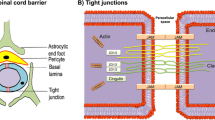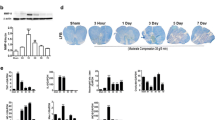Abstract
Salvianolic acid B (Sal B), a bioactive compound isolated from the Chinese medicinal herb danshen, is commonly used for the prevention and treatment of cardiovascular disease. The present study was performed to investigate the effect of Sal B on the blood–spinal cord barrier (BSCB) after spinal cord injury (SCI) in a rat model. Sal B (1, 10, and 50 mg/kg i.v.) was administered to rats immediately following SCI. The permeability of the BSCB and spinal cord tissue water content were evaluated. Additionally, the expression levels of tight junction proteins and heme oxygenase-1 (HO-1) were monitored by Western blot analysis. Enzyme-linked immunosorbent assay analysis of spinal cord tissue homogenates was performed 24 h post-SCI to evaluate the expression of inflammation-related cytokines. In addition, the motor recovery of SCI rats was assessed using the Basso, Beattie, and Bresnahan scoring system. Compared to the SCI group, rats treated with Sal B (10, 50 mg/kg) exhibited significantly reduced spinal cord tissue water content and BSCB permeability. Further, the motor function of rats was also greatly improved by Sal B administration. The expression of pro-inflammatory factors TNF-α and NF-κB was found to be greatly increased 24 h post-SCI, and this upregulation was significantly attenuated by Sal B treatment. The expression of ZO-1 and occludin was upregulated by Sal B (10 mg/kg) treatment after SCI, and this effect was blocked by the HO-1 inhibitor ZnPP. Taken together, our results clearly indicate that Sal B attenuates SCI by promoting the repair of the damaged BSCB, demonstrating that this molecule is a novel and promising therapeutic agent for human SCI.






Similar content being viewed by others
References
Akhtar AZ, Pippin JJ, Sandusky CB (2009) Animal studies in spinal cord injury: a systematic review of methylprednisolone. Altern Lab Anim 37(1):43–62
Basso DM, Beattie MS, Bresnahan JC (1995) A sensitive and reliable locomotor rating scale for open field testing in rats. J Neurotrauma 12(1):1–21
Beattie MS, Hermann GE, Rogers RC, Bresnahan JC (2002) Cell death in models of spinal cord injury. Prog Brain Res 137:37–47
Bilgen M, Dogan B, Narayana PA (2002) In vivo assessment of blood–spinal cord barrier permeability: serial dynamic contrast enhanced MRI of spinal cord injury. Magn Reson Imaging 20(4):337–341
Borgens RB, Liu-Snyder P (2012) Understanding secondary injury. Q Rev Biol 87(2):89–127
Can M, Gul S, Bektas S, Hanci V, Acikgoz S (2009) Effects of dexmedetomidine or methylprednisolone on inflammatory responses in spinal cord injury. Acta Anaesthesiol Scand 53(8):1068–1072
Chen YH, Du GH, Zhang JT (2000) Salvianolic acid B protects brain against injuries caused by ischemia–reperfusion in rats. Acta Pharmacol Sin 21(5):463–466
Chen T, Liu W, Chao X, Zhang L, Qu Y, Huo J, Fei Z (2011) Salvianolic acid B attenuates brain damage and inflammation after traumatic brain injury in mice. Brain Res Bull 84(2):163–168
Choi AM, Alam J (1996) Heme oxygenase-1: function, regulation, and implication of a novel stress-inducible protein in oxidant-induced lung injury. Am J Respir Cell Mol Biol 15(1):9–19
Cohen DM, Patel CB, Ahobila-Vajjula P, Sundberg LM, Chacko T, Liu SJ, Narayana PA (2009) Blood-spinal cord barrier permeability in experimental spinal cord injury: dynamic contrast-enhanced MRI. NMR Biomed 22(3):332–341
Coisne C, Engelhardt B (2011) Tight junctions in brain barriers during central nervous system inflammation. Antioxid Redox Signal 15(5):1285–1303
Durante W (2011) Protective role of heme oxygenase-1 against inflammation in atherosclerosis. Front Biosci 16:2372–2388
Esposito E, Cuzzocrea S (2011) Anti-TNF therapy in the injured spinal cord. Trends Pharmacol Sci 32(2):107–115
Fan ZK, Wang YF, Cao Y, Zhang MC, Zhang Z, Lv G, Lu W, Zhang YQ (2010) The effect of aminoguanidine on compression spinal cord injury in rats. Brain Res 1342:1–10
Huang WL, George KJ, Ibba V, Liu MC, Averill S, Quartu M, et al. (2007) The characteristics of neuronal injury in a static compression model of spinal cord injury in adult rats. Eur J Neurol 25:362–72
Jiang RW, Lau KM, Hon PM, Mak TC, Woo KS (2005) Chemistry and biological activities of caffeic acid derivatives from Salvia miltiorrhiza. Curr Med Chem 12:237–246
Joe Y, Zheng M, Kim HJ, Kim S, Uddin MJ, Park C, Ryu do G, Kang SS, Ryoo S, Ryter SW, Chang KC, Chung HT (2012) Salvianolic acid B exerts vasoprotective effects through the modulation of heme oxygenase-1 and arginase activities. J Pharmacol Exp Ther 341(3):850–858
Joshi M, Fehlings MG (2002) Development and characterization of a novel, graded model of clip compressive spinal cord injury in the mouse: Part 1. Clip design, behavioral outcomes, and histopathology. J Neurotrauma 19(2):175–190
Kniesel U, Wolburg H (2000) Tight junctions of the blood–brain barrier. Cell Mol Neurobiol 20(1):57–76
Lee IT, Luo SF, Lee CW, Wang SW, Lin CC, Chang CC, Chen YL, Chau LY, Yang CM (2009) Overexpression of HO-1 protects against TNF-alpha-mediated airway inflammation by down-regulation of TNFR1-dependent oxidative stress. Am J Pathol 175:519–532
Li Q, Han LP, Li ZH, Zhang JT, Tang MK (2010) Salvianolic acid B alleviate the disruption of blood–brain barrier in rats after cerebral ischemia–reperfusion by inhibiting MAPK pathway. Yao Xue Xue Bao 45(12):1485–1490
Liebner S, Czupalla CJ, Wolburg H (2011) Current concepts of blood–brain barrier development. Int J Dev Biol 55(4–5):467–476
Luo P, Tan Z, Zhang Z, Li H, Mo Z (2008) Inhibitory effects of salvianolic acid B on the high glucose-induced mesangial proliferation via NF-kappaB-dependent pathway. Biol Pharm Bull 31(7):1381–1386
Ptaszyńska-Sarosiek I, Niemcunowicz-Janica A, Janica J (2007) Spinal cord injuries opinions represented by neurologists. Arch Med Sadowej Kryminol 57(3):294–297
Qui Y, Rui YC, Zhang L, Li TJ, Zhang WD (2001) VEGF induced hyperpermeability in bovine aortic endothelial cell and inhibitory effect of salvianolic acid B. Acta Pharmacol Sin 22(2):117–120
Schröter A, Lustenberger RM, Obermair FJ, Thallmair M (2009) High-dose corticosteroids after spinal cord injury reduce neural progenitor cell proliferation. Neuroscience 161(3):753–763
Sharma HS (2005) Pathophysiology of blood–spinal cord barrier in traumatic injury and repair. Curr Pharm Des 11(11):1353–1389
Xu WB, Lv G, Wang YF, Lu XH, Huang T, Zhu Y, Jia LS (2009) Combination of dexamethasone and aminoguanidine reduces secondary damage in compression spinal cord injury. Cell Mol Neurobiol 29(5):683–689
Yamada K, Tanaka N, Nakanishi K, Kamei N, Ishikawa M, Mizuno T, Igarashi K, Ochi M (2008) Modulation of the secondary injury process after spinal cord injury in Bach1-deficient mice by heme oxygenase-1. J Neurosurg Spine 9(6):611–620
Zhou L, Zuo Z, Chow MS (2005) Danshen: an overview of its chemistry, pharmacology, pharmacokinetics, and clinical use. J Clin Pharmacol 45(12):1345–1359
Acknowledgments
This work was supported by National Science Foundation for China, no.81101421, no. 81100924, 81272074; Doctor-beginning Science Foundation of Liaoning Province, no.20121094; and New groups Foundation of the Department of Education for Liaoning Province, no. LT2011013.
Author information
Authors and Affiliations
Corresponding author
Rights and permissions
About this article
Cite this article
Fan, Zk., Lv, G., Wang, Yf. et al. The Protective Effect of Salvianolic Acid B on Blood–Spinal Cord Barrier After Compression Spinal Cord Injury in Rats. J Mol Neurosci 51, 986–993 (2013). https://doi.org/10.1007/s12031-013-0083-8
Received:
Accepted:
Published:
Issue Date:
DOI: https://doi.org/10.1007/s12031-013-0083-8




